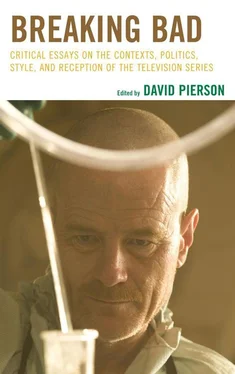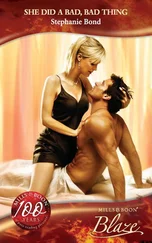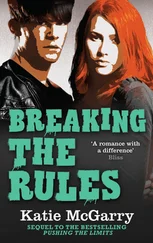Tuco’s role in the series, although notable, lasts for only four episodes before he is tracked down by, and killed in a gunfight with, Hank Schrader (Dean Norris) of the Drug Enforcement Agency (DEA). Tuco’s scenes are brief, but memorable, although the latter is arguably due to the over-the-top manner in which they play to certain stereotypes. Other Latino characters largely avoid such stereotyping, however. It is almost as if Vince Gilligan set the baseline with the most outrageous character possible in order to demonstrate the sheer distance from which the series was about to diverge. After a period during which White attempts to set up his own methamphetamine distribution network, he is introduced to businessman Gustavo Fring (Giancarlo Esposito). In one of only a few examples of non-geographically appropriate casting in Breaking Bad , [7] Many border narratives in American film and television have been criticized for employing Carribean [Benicio del Toro in Traffic (2000)], South American, and even Spanish actors [Javier Bardem in No Country for Old Men (2007)] to depict Mexican or Chicano characters.
the Italian/African-American Esposito was chosen to depict Fring, who would become one of the narrative’s primary and most interesting characters in seasons three and four. Early on in season three, Fring defies easy character analysis. In addition to being the notional drug kingpin of the American Southwest, he is a shrewd businessman who owns a chain of successful fast food restaurants called “Los Pollos Hermanos” (translated as “The Chicken Brothers”). Other than the color of his skin, Fring is generally portrayed as a sort of mainstream white character. He dresses fastidiously, driving carefully to and from work, making sure not to exceed the speed limit. He has close ties to the Albuquerque community, donating money to charitable causes and even partnering with the DEA in fundraising. Fring is meticulous and controlled as a character, both in his daily life as the owner/manager of his restaurants and also as a drug distributor. Despite his secrecy, it is quickly evident that he is Latin American in origin and has connections within the Mexican drug cartels. As his importance within the narrative increases, the series reveals a bit more about his past. Fring is in fact not originally from Mexico, but instead Chile. Due to his business acumen, he has become the American contact for at least one of the cartels. He is not just the brains behind the operation, however, and can be moved to violent proaction. In “Box Cutter” (7/17/11), one of the most chilling episodes of the entire series, Fring violently dispatches his own henchman Victor (Jeremiah Bitsui) after the latter was seen near a crime scene. He arrives at the underground meth lab constructed for White and Pinkman, methodically takes off his clothes, neatly folds and hangs them without saying a word, dons a protective work suit, and then savagely cuts Victor’s throat with a box cutter.
Despite his occasional use of violence, Fring is nothing like Tuco. He is not capricious: nothing he does is without a significant amount of risk assessment. He is not addicted to meth: indeed, he has real reservations in working with Pinkman, as he views that even being associated with addicts is risky business. He is humanized; we learn a bit about his philosophy when White is invited to dine at his house. And finally, he is given a background in a key flashback in “Hermanos” (9/4/11), the audience is given insight into Fring’s complicated relationship with Don Eladio (Steven Bauer), boss of one of the Mexican cartels. Fring and his partner Max (James Martinez), with whom Fring has begun making methamphetamine, are brought to meet Don Eladio. After bantering with them for a bit, Eladio has Max shot, forcing Fring to watch as his friend bleeds out. This traumatic episode provides a clue about Fring’s background, one that is never fully explored. There are several hints throughout the series, one mentioned by Eladio in this scene, that Fring was involved in some aspect with the violent excesses that occurred during and immediately following Augusto Pinochet’s 1973 military coup in Chile. [8] In overthrowing the democratically-elected government of Socialist Salvador Allende, Pinochet had not only the support of the right-wing army but also of the American Central Intelligence Agency (CIA). Some members of the Chilean military and police involved in the program of torture and assassination were CIA assets, as a memo from the National Intelligence Council made evident following the declassification of materials in 2000: “Many of Pinochet’s officers were involved in systematic and widespread human rights abuses following Allende’s ouster. Some of these were contacts or agents of the CIA or U.S. military” (2). In the episode “Hermanos,” Agent Schrader notes that no information exists for Gustavo Fring prior to his application for Mexican citizenship in 1986. He wonders if Fring’s identity is assumed but expresses surprise that he could have received American citizenship in 1989 without a thorough background check. The possibility exists that Fring had help from the CIA in establishing his new identity, although this hypothesis is unlikely given Fring’s move into narcotics. Regardless of how he entered the country, a Pinochet loyalist becoming instrumental in the U.S. drug trade is a minor example of “Blowback,” whereby American support of a foreign entity empowers that organization or individual to later engage in actions deleterious to American interests.
An additional indication comes in the episode “One Minute” (5/2/10) when Hector Salamanca (Mark Margolis) refers to Fring as “Generalissimo,” suggesting that the latter held some power or authority within Pinochet’s military junta. During this bloody episode in Chilean history, various tactics such as torture and assassination were employed by Pinochet’s agents against Marxists and other political dissidents. Although the series never makes clear Fring’s specific involvement or even which side he supported, hints dropped by both Eladio and Hector suggest that he played a role in the bloodshed, in fact a significant enough one that he was forced to change his name upon immigrating to Mexico to begin a new life.
By the time of his death in the episode “Face Off” (10/9/11), Fring is a well-rounded character with interesting and complex motivations. He is not at all the addicted, violent, shallow stereotype of an over-the-top Latin American drug kingpin a la Tony Montana or Tuco Salamanca. The fact that Fring is black also establishes an interesting aspect of Latino identity not often referenced in popular culture. During the sixteenth through the nineteenth centuries, the Middle Passage brought African slaves not only to the eastern shores of North America, but also to Brazil and the Caribbean, as well as a few Central American nations such as Panama. The “Black Hispanic” is rarely portrayed in American depictions of Latinos, and the choice of Esposito for the role of Fring introduced complexity to the series’ racial depictions. Furthermore, in deciding that a Chilean character would play a lead role in serving as conduit between the Mexican drug cartels and U.S. market, Vince Gilligan signaled the complexity of border politics, where not only Mexicans seek to create a new life by crossing from south to north.
Much as Fring and Tuco establish that, north of the border, Breaking Bad is as adept at obliterating as it is employing Latino stereotypes, so too does the series do the same with the cartel south of the border. In the episode “Salud” (9/18/11), Don Eladio instructs Fring to bring him the maker of the blue meth. Not wanting to identify White as the mastermind behind the drug, but knowing that he cannot ignore Eladio’s summons, Fring flies to Mexico and brings Pinkman with him. He passes Pinkman off as the genius behind the blue meth and, in a tense cook overseen by a Mexican chemist, Pinkman produces a batch with a purity index above 95 percent, almost as pure as White’s. Getting a glimpse into the machinations of a Mexican drug lab, replete with a university-trained biochemist, is not the type of scene that would usually find its way into a drug narrative, where the product simply shows up on the street in the United States or is seen mid-transport. What happens next, however, fits a stereotype commonly associated with portrayals of Latin American drug cartels. Fring and Pinkman are taken to Eladio’s villa and, after some preliminary business talk and a toast of friendship, are treated to a party with liberal amounts of alcohol and scantily-clad women. Such scenes are commonplace in drug narratives that shine a light on the cartels, particularly those involving depictions of the Colombian cartels. Pablo Escobar, long-time chieftain of the Medellin Drug Cartel, was well known for throwing such parties, [9] According to the Associated Press (1992), Pablo Escobar routinely arranged orgies for himself and his henchman, even while “behind bars” in a prison he had ordered built to house him after deciding to turn himself in!
and they have become staples in depicting powerful drug lords ( Blow , Scarface , and the television series Kingpin ). Breaking Bad , however, subverts this genre plot point. Although Eladio’s party begins in a predictable fashion, it soon devolves into utter chaos. Having poisoned the tequila with which he, Eladio, and Eladio’s capos had toasted, Fring excuses himself to the bathroom to force vomit. All around the complex, Eladio’s henchmen begin dying; the party reaches an ignominious end as the scantily-clad women run off, taking with them some of Eladio’s possessions and handfuls of cash and even stealing a few of his cars. After beginning true to form in pure debauchery, the party ends as Eladio dies while his empire crumbles around him, foreshadowing what will happen to Fring a few episodes later and perhaps what will happen to White by the end of the series.
Читать дальше












